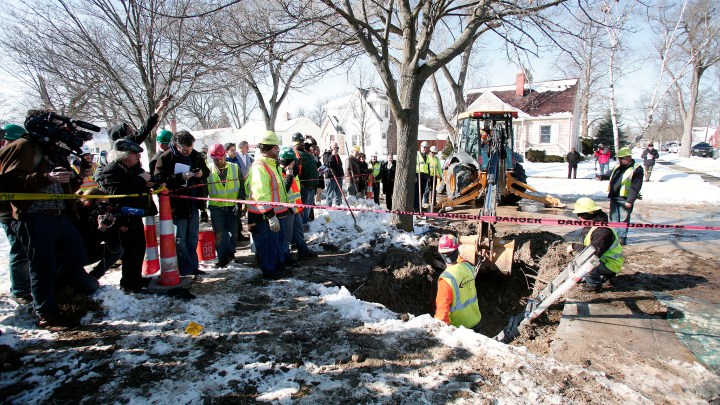
Infrastructure plan targets lead pipe hazards

Most of us take clean tap water for granted. But in millions of homes, that tap water could actually be contaminated with lead.
“The main issue with lead is that it’s a powerful neurotoxin, and it really impacts especially young children,” said Charlotte Jameson, chief policy officer for the non-profit Michigan Environmental Council.
Even low levels of lead exposure can cause permanent damage to kids’ brains and nervous systems, and a host of ailments for adults too. There is no known safe level of lead exposure, according to the Environmental Protection Agency and the Centers for Disease Control and Prevention.
“It’s really scary if you think about it, not being able to trust the water that’s coming out of your tap really does impact your daily life. Thinking that maybe your water impacted your child’s health is a really scary thing to realize as a parent,” she said.
In 2014, this became a reality for the residents of Flint, Michigan. In an effort to save money, the city switched its water source but failed to treat the new water with chemicals that prevent corrosion. Without corrosion control, Flint’s network of old lead pipes leached the toxic metal into the drinking water, poisoning city residents.
For many, the Flint water crisis drew attention to the hazards of lead contamination for the first time. But the factors that created this crisis aren’t unique to Flint.
“There are a thousand communities around America that could be a Flint if things go wrong in the water supply,” said Gabriel Filippelli, executive director of the Environmental Resilience Institute at Indiana University.
According to the Natural Resources Defense Council, there are around 9 to 12 million lead pipes serving more than 20 million households across the country.
For most of the 19th century, lead was a common ingredient in pipes, paint and even gasoline. It was an ideal material because it was flexible, malleable and cheap.
“It was the middle part of last century before people realized that this stuff is dangerous. It took until the middle of the 1970s and into the 1980s for the Clean Air Act and Clean Water Act to list lead as a toxin, which meant that you couldn’t put it in pipes anymore,” Filippelli explained.
Erik D. Olson, the senior strategic director for health at the NRDC, said replacing lead pipes is long overdue.
“We know that these lead service lines are the major source of lead in people’s drinking water. The best thing to do is to pull those lead pipes out of the ground to substantially reduce the risk for millions of people,” he said.
Service lines are big underground pipes that connect homes to the municipal water source. They’re the primary cause of lead-water contamination, though lead plumbing inside of homes can also contribute to the problem.
The Biden administration has made replacing these pipes a focal point of its infrastructure spending. The federal infrastructure law, passed last year, provided $15 billion to remove lead service lines.
States and municipalities are tackling the problem too. Newark, New Jersey, already replaced all of its 23,000 lead service lines in just three years. These replacement efforts can have positive economic outcomes.
“It creates real economic benefits and is just a mammoth job creator. Those funds are tilled back into the community where the money is being spent. The benefits of replacing can be ten times higher than the costs,” Olson said.
A study by business group E2 indicates that replacing all lead service lines would create 56,080 jobs annually over 10 years. But it isn’t cheap. It costs roughly $5,000 to replace a single service line. According to Olson, the $15 billion federal investment is only about a third of what’s needed.
Filippelli at the Environmental Resilience Institute said property owners could end up footing the rest of the bill. “Replacing this infrastructure will cost ratepayers eventually. So, there is an economic impact on you, the consumer of the water, in terms of a higher bill.”
This could be especially tough for low-income communities of color, who experience high rates of lead exposure and are more likely to live in older buildings that contain lead plumbing and paint and reside in urban areas that rely on lead service lines.
Erik Olson at the NRDC said current initiatives to replace lead pipes in these communities — and across the country — are not moving fast enough.
There’s a lot happening in the world. Through it all, Marketplace is here for you.
You rely on Marketplace to break down the world’s events and tell you how it affects you in a fact-based, approachable way. We rely on your financial support to keep making that possible.
Your donation today powers the independent journalism that you rely on. For just $5/month, you can help sustain Marketplace so we can keep reporting on the things that matter to you.

















